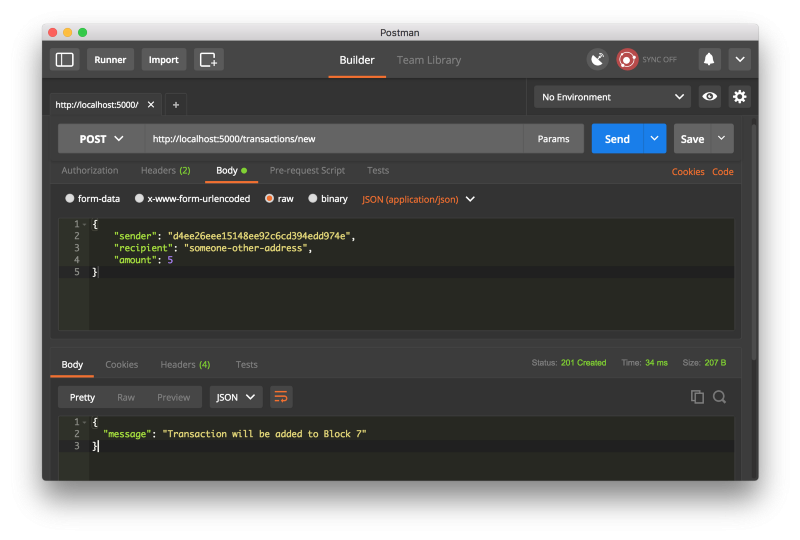
用python 实现自己的区块链(有python基础)
发布时间:2018-07-03
最近大火的虚拟货币比特币深受年轻投资人的喜爱而区块链就是比特币的基础技术,感兴趣的朋友是可以自己用python写一个非常基础和简单的区块链
写之前我写给大家解释一些名词和用到的东西。
一、 什么是区块链:区块链是一个不可变得,有序的被称之为块的记录链,它们可以包含交易、文件或者任何你喜欢的数据,但最重要的是,它们用hash连接在一起。
二、一个完整的快包含:一个索引,一个时间戳,一个事物列表,一个校验, 一个前快的散链表
三、挖矿:挖矿其实非常简单就做了以下三件事:
1、计算工作量证明poW
2、通过新增一个交易赋予矿工(自已)一个币
3、构造新区块并将其添加到链中
四、工作量证明算法:
使用该算法来证明是如何在区块上创建和挖掘新的区块,pow的目标是计算出
一个符合特定条件的数字,这个数字对于所有人而言必须在计算上非常困难,
但易于验证,这就是工作证明背后的核心思想
计算难度与目标字符串需要满足的特定字符串成正比。
五 、准备:1、自己觉得用的最顺手的IDE(我是pycham)
2、下载 pip install Flask,requests
3、下载支持HTTP的客户端,我这用的是Postman
4、Flask是python 的web轻量级框架,用于web快速开发非常好,我有一个论坛的项目就是用它写的。
六、代码奉上,我的代码每个方法都注释的非常详细,有基础的都能看懂,如果中间有不懂或者报错的地方欢迎评论留言
七、注意我这就一个类就搞定了。
import hashlib
import json
import requests
from textwrap import dedent
from time import time
from uuid import uuid4
from urllib.parse import urlparse
from flask import Flask, jsonify, request
class Blockchain(object):
def __init__(self):
...
self.nodes = set()
# 用 set 来储存节点,避免重复添加节点.
...
self.chain = []
self.current_transactions = []
#创建创世区块
self.new_block(previous_hash=1,proof=100)
def reister_node(self,address):
"""
在节点列表中添加一个新节点
:param address:
:return:
"""
prsed_url = urlparse(address)
self.nodes.add(prsed_url.netloc)
def valid_chain(self,chain):
"""
确定一个给定的区块链是否有效
:param chain:
:return:
"""
last_block = chain[0]
current_index = 1
while current_index<len(chain):
block = chain[current_index]
print(f'{last_block}')
print(f'{block}')
print("\n______\n")
# 检查block的散列是否正确
if block['previous_hash'] != self.hash(last_block):
return False
# 检查工作证明是否正确
if not self.valid_proof(last_block['proof'], block['proof']):
return False
last_block = block
current_index += 1
return True
def ressolve_conflicts(self):
"""
共识算法
:return:
"""
neighbours = self.nodes
new_chain = None
# 寻找最长链条
max_length = len(self.chain)
# 获取并验证网络中的所有节点的链
for node in neighbours:
response = requests.get(f'http://{node}/chain')
if response.status_code == 200:
length = response.json()['length']
chain = response.json()['chain']
# 检查长度是否长,链是否有效
if length > max_length and self.valid_chain(chain):
max_length = length
new_chain = chain
# 如果发现一个新的有效链比当前的长,就替换当前的链
if new_chain:
self.chain = new_chain
return True
return False
def new_block(self,proof,previous_hash=None):
"""
创建一个新的块并将其添加到链中
:param proof: 由工作证明算法生成证明
:param previous_hash: 前一个区块的hash值
:return: 新区块
"""
block = {
'index':len(self.chain)+1,
'timestamp':time(),
'transactions':self.current_transactions,
'proof':proof,
'previous_hash':previous_hash or self.hash(self.chain[-1]),
}
# 重置当前交易记录
self.current_transactions = []
self.chain.append(block)
return block
def new_transaction(self,sender,recipient,amount):
# 将新事务添加到事务列表中
"""
Creates a new transaction to go into the next mined Block
:param sender:发送方的地址
:param recipient:收信人地址
:param amount:数量
:return:保存该事务的块的索引
"""
self.current_transactions.append({
'sender':sender,
'recipient':recipient,
'amount':amount,
})
return self.last_block['index'] + 1
@staticmethod
def hash(block):
"""
给一个区块生成 SHA-256 值
:param block:
:return:
"""
# 必须确保这个字典(区块)是经过排序的,否则将会得到不一致的散列
block_string = json.dumps(block,sort_keys=True).encode()
return hashlib.sha256(block_string).hexdigest()
@property
def last_block(self):
# 返回链中的最后一个块
return self.chain[-1]
def proof_of_work(self,last_proof):
# 工作算法的简单证明
proof = 0
while self.valid_proof(last_proof,proof)is False:
proof +=1
return proof
@staticmethod
def valid_proof(last_proof,proof):
# 验证证明
guess = f'{last_proof}{proof}'.encode()
guess_hash = hashlib.sha256(guess).hexdigest()
return guess_hash[:4] =="0000"
# 实例化节点
app = Flask(__name__)
# 为该节点生成一个全局惟一的地址
node_identifier = str(uuid4()).replace('-','')
# 实例化Blockchain类
blockchain = Blockchain()
# 进行挖矿请求
@app.route('/mine',methods=['GET'])
def mine():
# 运行工作算法的证明来获得下一个证明。
last_block = blockchain.last_block
last_proof = last_block['proof']
proof = blockchain.proof_of_work(last_proof)
# 必须得到一份寻找证据的奖赏。
blockchain.new_transaction(
sender="0",
recipient=node_identifier,
amount=1,
)
# 通过将其添加到链中来构建新的块
previous_hash = blockchain.hash(last_block)
block = blockchain.new_block(proof,previous_hash)
response = {
'message': "New Block Forged",
'index': block['index'],
'transactions': block['transactions'],
'proof': block['proof'],
'previous_hash': block['previous_hash'],
}
return jsonify(response), 200
# 创建交易请求
@app.route('/transactions/new',methods=['POST'])
def new_transactions():
values = request.get_json()
# 检查所需要的字段是否位于POST的data中
required = ['seder','recipient','amount']
if not all(k in values for k in request):
return 'Missing values',400
#创建一个新的事物
index = blockchain.new_transaction(values['sender'], values['recipient'], values['amount'])
response = {'message': f'Transaction will be added to Block {index}'}
return jsonify(response), 201
# 获取所有快信息
@app.route('/chain',methods=['GET'])
def full_chain():
response = {
'chain':blockchain.chain,
'length':len(blockchain.chain),
}
return jsonify(response),200
# 添加节点
@app.route('/nodes/register',methods=['POST'])
def register_nodes():
values = request.get_json()
nodes = values.get('nodes')
if nodes is None:
return "Error: Please supply a valid list of nodes", 400
for node in nodes:
blockchain.register_node(node)
response = {
'message': 'New nodes have been added',
'total_nodes': list(blockchain.nodes),
}
return jsonify(response), 201
# 解决冲突
@app.route('/nodes/resolve', methods=['GET'])
def consensus():
replaced = blockchain.resolve_conflicts()
if replaced:
response = {
'message': 'Our chain was replaced',
'new_chain': blockchain.chain
}
else:
response = {
'message': 'Our chain is authoritative',
'chain': blockchain.chain
}
return jsonify(response), 200
if __name__ == '__main__':
app.run(host='0.0.0.0',port=5000)
代码弄好启动你的项目以后打开Postman 完成以下操作

让我们通过请求 http://localhost:5000/mine进行采矿

创建一个交易请求,请求 http://localhost:5000/transactions/new
后续会继续更新。
热门文章
行业早报2019-01-15 nginx+php 开启PHP错误日志
nginx+php 开启PHP错误日志
行业早报2019-01-15 为什么你说了很多遍,对方还是不听? 2018-09-25
为什么你说了很多遍,对方还是不听? 2018-09-25
行业早报2019-01-15 【Ruby on Rails实战】3.1 宠物之家论坛管理系统介绍
【Ruby on Rails实战】3.1 宠物之家论坛管理系统介绍
行业早报2019-01-15 从凡人到筑基期的单片机学习之路
从凡人到筑基期的单片机学习之路
行业早报2019-01-15 jmeter单台大数量并发
jmeter单台大数量并发
行业早报2019-01-15 Go在Windows下开发环境搭建
Go在Windows下开发环境搭建
行业早报2019-01-15 ES-科普知识篇
ES-科普知识篇
行业早报2019-01-15 Hbase 之 由 Zookeeper Session Expired 引发的 HBASE 思考
Hbase 之 由 Zookeeper Session Expired 引发的 HBASE 思考
行业早报2019-01-15 谷歌大脑专家详解:深度学习可以促成哪些产品突破?
谷歌大脑专家详解:深度学习可以促成哪些产品突破?
行业早报2019-01-15 EventLoop
EventLoop
相关推荐
 实名认证
实名认证
 未实名
未实名


